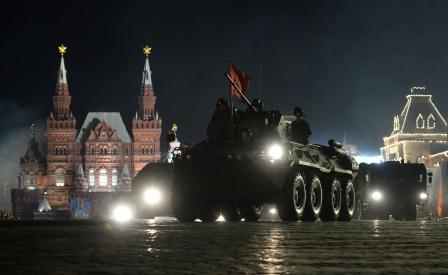ID :
406821
Mon, 05/16/2016 - 18:05
Auther :
Shortlink :
https://oananews.org//node/406821
The shortlink copeid
US Missile Defense in Eastern Europe: How Russia Will Respond

According to Russian Foreign Ministry Spokesperson Maria Zakharova, Moscow has a right to 'appropriately respond' to the US missile defense systems being deployed in Eastern Europe. What exactly will that response be? Sputnik investigates.
Late last week, commenting on the Washington's deployment of the new Aegis Ashore missile defense system at the Deveselu military base in Romania, Zakharova said that "what we see from our Western partners cannot be called a betrayal, because a betrayal is only possible from one's close friends. These were nefarious steps – the violation of agreements…Considering how this situation is developing, we of course reserve the right to respond."
Earlier, Russian President Vladimir Putin said that the system being deployed in Romania was clearly not a defensive complex, but part of the US's strategic nuclear capability. "Now, after the deployment of those anti-missile system elements, we'll be forced to think about neutralizing developing threats to Russia's security," Putin said.
The shield, the President added, was another step by NATO aimed at increasing international tensions and attempting to drag Russia into a new arms race. "We're not going to be dragged into this race. We'll go our own way. We'll work very accurately without exceeding the plans to finance the re-equipment of our army and navy, which have already been laid out for the next several years," Putin emphasized.
NATO General Secretary Jens Stoltenberg attempted to calm Moscow's weariness over the $800 million facility by suggesting that the system was "exclusively defensive," and could not be used for offensive purposes "even if we wanted to."
Meanwhile, Deputy Secretary of Defense Robert Work went further, saying the defense shield was really aimed against Iran, not Russia. "As long as Iran continues to develop and deploy ballistic missiles, the United States will work with our allies and partners to defend against this threat," Work said, speaking at a groundbreaking ceremony for another Aegis Ashore ballistic missile defense site being built in Redzikowo, Poland. That system is expected to become operational in 2018.
Theoretically, the Romanian missile defense complex by itself is not expected to present a threat to the strategic balance. However, as Mikhail Ulyanov, the director of the Foreign Ministry's Department for Non-Proliferation and Arms Control emphasized, it is impossible to determine when the US and NATO will consider the level of security in Europe to be 'sufficient'.
"Today, the base in Romania has been brought to operational readiness; tomorrow the first brick will be laid for the construction of a similar base in Poland. Then there are the ships, moving freely through the seas, including the Black Sea, the Barents Sea and the Baltic Sea. And the US has refused discussing any limitations," Ulyanov said, cited by Russian media.
Furthermore, according to Russia's permanent NATO representative Alexander Grushko, Moscow remains very concerned about the possibility of the US rapidly converting the missile systems to provide them with offensive capabilities, something entirely possible given the nature of the launchers being deployed. "By deploying the MK-41 universal launchers, capable of launching medium-range missiles, at the Aegis Ashore facilities, the US is seriously undermining the Treaty on Intermediate-Range Nuclear Forces (INF)," Grushko said.
Just how grave is the threat, and how can Russia adequately respond? For answers to these questions, independent Russian online newspaper Svobodnaya Pressa turned to Russian military expert Viktor Murakhovsky. Speaking to the paper, Murakhovsky, a member of Russia's powerful Military-Industrial Commission, explained that the biggest danger lies in the fact "that the US missile defense systems are deployed on the MK-41 vertical launching system, which the US Navy has used for many years to launch its Tomahawk cruise missiles."
"Under the INF Treaty of 1988, signed by the Soviet Union and the United States, the signatories pledged not to produce, test or deploy ground-based missiles like the Tomahawk; they were limited to air and sea use. But in fact, the medium-range missiles used by the navy are no different, apart from their launch platform, from their ground-based counterparts. Therefore, the deployment of US Tomahawk launchers in Europe really is a threat to the Russian Federation." "At present," Murakhovsky recalled, "the Aegis Ashore facility in Romania is equipped with SM-3 interceptor missiles of the Block 1B modification. They are not physically or technically capable of intercepting our European-based ICBMs."
"But just around the corner is the Block 2A modification. And these interceptor missiles can create a potential threat. We know that such missiles are still under development, and the Americans plan to equip their first Aegis Ashore facility in Poland with them, and then the other land and sea-based systems."
"Theoretically at least," the official underlined, "Block 2A missiles could pose a threat to the potential of missiles in European Russia."
Recently, Russian Strategic Missile Forces commander Sergei Karakaev emphasized that US missile defense does not currently threaten Russia's strategic nuclear capability. This, according to Murakhovsky, is due at least in part to Russia's long-term development of new, missile defense-defeating missile systems. "We know that our Yars mobile missile systems, already in production, and the Yars-M, which is undergoing testing, as well as the promising [RS-28] Sarmat ICBM, are equipped with systems allowing them to defeat missile defense. In this sense, our plans to counter US missile defense are nothing new…"





